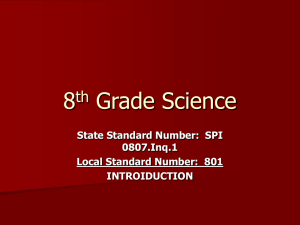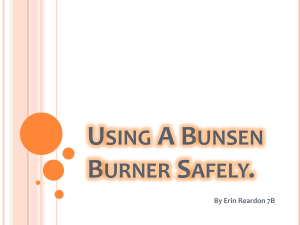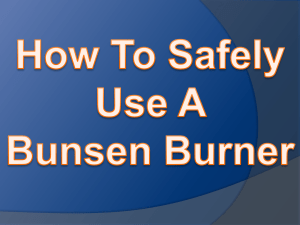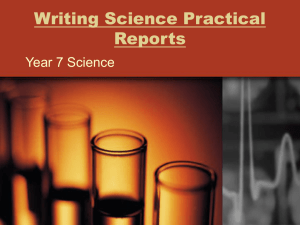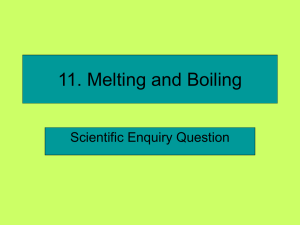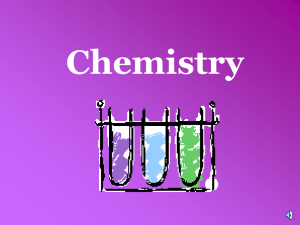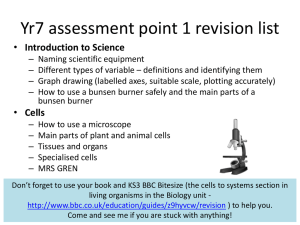Science and Technology
advertisement
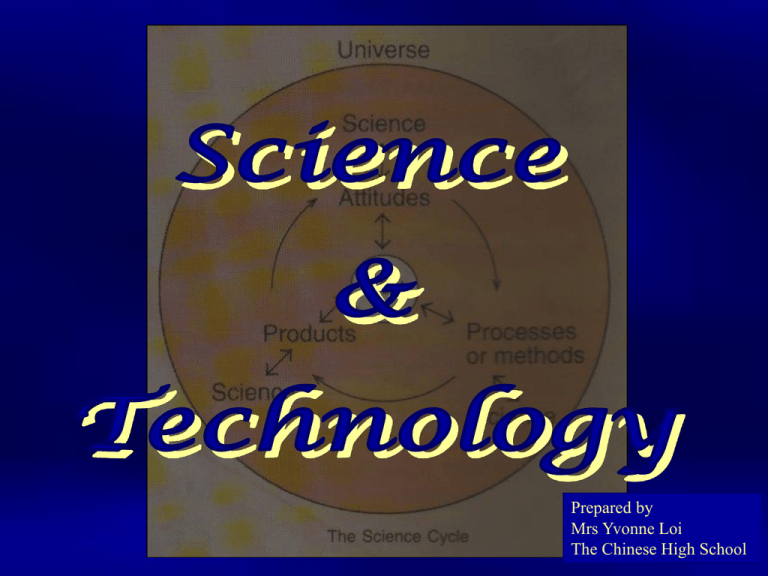
Prepared by Mrs Yvonne Loi 1 The Chinese High School Objectives • To discuss what the science process skills and attitudes important to the learning of science are • To state the laboratory safety rules and recognise the various hazard symbols • To state the names and functions of some common laboratory apparatus (listed in workbook) • To draw, in proportion, sectional diagrams of the apparatus 2 Objectives • To dismantle the Bunsen burner and explain how the various parts contribute to its working • To know the procedure of lighting a Bunsen burner and able to light it correctly and with confidence when doing practical work • To obtain either a luminous or nonluminous flame by adjusting the size of the air holes 3 Objectives • To draw the diagram of a non-luminous flame and label the various parts, i.e. dark zone of unburnt gas, blue zone of partial combustion, almost colourless zone of complete combustion and hottest part of the flame • To explain the causes of the luminous and non-luminous appearance of the flame • To state which flame is more suitable for heating and explain why 4 Objectives • To carry out appropriate action during a strike back 5 Do you know what science is all about? The influence of science is all around us. For example, a homemaker needs to know science to cook well-balanced and nutritious meals for his or her family. 6 Many devices that we used, such as the telephone, cassette player and fluorescent lamp, are based on scientific discoveries. Fight against diseases such as AIDS has been largely carried out by scientific research. 7 Scientists are also making new discoveries to solve global problems such as air and water pollution. From such findings, they are able to warn us about new hazards to our health so that certain precautions can be taken. Hazy weather 8 Science As An Inquiry Science is the systematic study of nature and how it affects us and the environment. 9 Branches of Science: Biology - The study of living things. Chemistry - The study of substances and how they interact. Physics - The study of matter, energy and natural forces. Astronomy - The study of the sun, the moon, the stars, planets and other heavenly bodies. Geology - The study of structures of earth. 10 In the past, science was only described as a body of knowledge. Later definitions of science included the adoption of certain methods or skills to discover and apply scientific knowledge. Today, the study and practice of science involve three major elements - attitudes - processes or methods - products 11 Attitudes - Science encourages man to develop positive attitudes. The attitudes important to the learning of science are Curiosity Perseverance 12 Positive approach to failure Cooperation with others Open-mindedness Tolerance 13 Impartiality Integrity Healthy scepticism 14 Refusal to believe superstitions Processes or methods - Science process skills are used to develop new processes or methods of investigating and understanding science. Science process skills refer to the different types of skills including thinking and reasoning skills, which are needed for scientific investigation. They are broadly divided into basic process skills and integrated process skills. 15 The basic process skills are To use our senses to obtain information about objects, events and changes. Observe? To transmit and receive information presented in various forms - verbal, written, tabulated, graphical or pictorial. Communicate? To group objects or events according to common properties. Classify? 16 To draw conclusions from observations. Infer? To find out the physical properties (e.g. length, area and mass) of matter accurately with the help of measuring instruments. Measure? To make an educated guess of how things may turn out based on previous experience or knowledge. To approximate. Predict? Estimate? 17 Integrated process skills require pupils to think at a higher level and to consider more than one thought at a time. They combine several of the basic process skills to form better ways of solving problems. Scientists have to carry out experiments to test the hypotheses or to prove proposed concepts. In carrying out the experiments, several integrated process skills are required. 18 The integrated process skills are - Observing carefully and measuring accurately This skill involves using our five senses, sight, smell, hearing, taste and touch, to gather information or make accurate measurements about a topic under study. 19 - Communicating effectively This skill involves recording observations or measurements in appropriate forms such as tables, charts, graphs, labelled drawings, formulae and other forms of communication for easy reference. 20 - Making inference and developing a hypothesis An inference is a statement one arrives at after much reasoning based on observations or measurements. The making of an inference involves thinking skills and discussion with others to come up with the best possible explanation for the observations or measurements. 21 For an inference, scientists usually come up with a hypothesis which is a suggested explanation that can be tested through experiments. 22 - Planning or designing experiments to test the hypothesis This skill involves deciding what apparatus to use, how to put them together, what observations to make or measurements to take and how to do a fair test on the validity of the hypothesis. 23 Science process skills will help you to expand your scope of learning in science as well as in other subjects through experience. You begin with simple ideas which are combined to form new and complex ideas. All your ideas are valuable because they help you to become a better decision maker, consumer, problem solver, citizen and member of our global society. 24 Products - The information and ideas of science that have been recorded as scientific knowledge are called products. Most scientists build on what other scientists have discovered. This practice saves a lot of time and energy. As new discoveries are made, they are added to the scientific knowledge base. Thus science has changed over time and is subjected to further changes. 25 The understanding of the three major elements of learning science is important to anyone who studies and practises science. 26 Our innate experience often makes us curious (attitudes) about phenomena occurring in nature. This curiosity about nature in turn motivates us to develop new ways of processing ideas or solving problems (processes or methods). These lead to the construction of new scientific knowledge (products). 27 28 Successful learning in science and other subjects is the result of carrying out continuous investigations relating to the subjects. This will enrich a person’s experience. A learning cycle is thus formed and continues to repeat itself as learning is a lifelong process that never stops. 29 The Scientific Method Different scientists may be carrying out different scientific investigations but they all share the common methods of investigation. The scientific method is the most common method used by scientists in their investigations. 30 The Scientific Method - Investigative The steps in the Scientific Method - Observation - Hypothesis - Experiment - Conclusion To actually do a science experiment, many more steps are needed. The following more accurately reflects the course of an actual experimental investigation. 31 - Initial observation. - You notice something, and wonder why it happens. You see something and wonder what causes it. You want to know how and why something works. You ask questions about what you have observed. (Write down what you have observed.) Example: Cooking instructions tell you to add salt to water before boiling it. 32 - Information gathering. - Find out about what you want to investigate. Read books, magazines or ask professionals who might know in order to learn about the effect or area of study. (Keep track of where you got your information.) Example: Cooking instructions tell you to add salt to water before boiling it. 33 - Title the project. - Choose a title that describes the effect or thing you are investigating. The title should be short and summarize what the investigation will deal with. Example: The Effect of Salt on the Boiling Point of Water. 34 - State the purpose of the project. - What do you want to find out? Example: To find out how salt affects the boiling point of water. 35 - Identify variables. - Based on your gathered information, make an educated guess about what types of things affect the system you are working with. (Identifying variables is necessary before you can make a hypothesis.) Example: Variables - Amount of salt Constant - Amount of distilled water The container to use The place to perform the experiment etc. 36 - Make HYPOTHESIS. - - When you think you know what variables may be involved, think about ways to change one at a time. If you change more than one at a time, you will not know what variable is causing your observation. Sometimes variables are linked and work together to cause something. At first, try to choose variables that you think act independently of each other. At this point, you are ready to translate your questions into hypothesis. (A hypothesis is a question which has been reworded into a form that can be tested by an experiment.) 37 - - - Make a list of your answers to the questions you have. This can be a list of statements describing how or why you think the observed things work. These questions must be framed in terms of the variables you have identified. There is usually one hypothesis for each question you have. You must do at least one experiment to test each hypothesis. (This is a very important step.) Example: Adding salt to boiling water will cause the water 38 to boil at a higher temperature. - Design experiments to test your hypothesis. - - Design an experiment to test each hypothesis. Make a step-by-step list of what you will do to answer your questions. (This list is called an experimental procedure.) For an experiment to give answers you can trust, it must have a “control.” (A control is an additional experimental trial or run. It is a separate experiment, done exactly like the others. The only difference is that no experimental variables are changed.) 39 (A control is a neutral "reference point" for comparison that allows you to see what changing a variable does by comparing it to not changing anything.) (Dependable controls are sometimes very hard to develop. They can be the hardest part of a project.) (Without a control you cannot be sure that changing the variable causes your observations.) (A series of experiments that includes a control is called a "controlled experiment.”) 40 - Experiments are often done many times to guarantee that what you observe is reproducible, or to obtain an average result. (Reproducibility is a crucial requirement. Without it you cannot trust your results. Reproducible experiments reduce the chance that you have made an experimental error, or observed a random effect during one particular experimental run.) 41 - Boil 200 cm3 of distilled water on a stove. - Measure the temperature of the boiling water. Record the highest temperature reading. This is the control to compare with. - Measure salt using a teaspoon. Level the spoonful. - Add the measured salt to the boiling water and stir. - Measure the temperature of the boiling water with the salt in it. Record the highest temperature reading. REPEAT. 42 Guidelines for experimental procedures. - Select only one thing to change in each experiment. (Things that can be changed are called variables.) - Change something that will help you test your hypothesis. - The procedure must tell how you will change this one thing. - The procedure must explain how you will measure the amount of change. - Each type of experiment needs a "control" for comparison so that you can see what the change actually did. 43 - Obtain materials and equipment. - - Make a list of the things you need to do the experiments, and prepare them. Salt Distilled Water Beaker Teaspoon Thermometer Stirrer 44 - Do the experiment and record data. - Experiments are often done in series. A series of experiments can be done by changing one variable a different amount each time. A series of experiments is made up of separate experimental “runs.” During each run you make a measurement of how much the variable affected the system under study. For each run, a different amount of change in the variable is used. 45 - - This produces a different amount of response in the system. You measure this response, or record data, in a table for this purpose. This is considered "raw data" since it has not been processed or interpreted yet. When raw data gets processed mathematically, for example, it becomes results. As you do experiments, record all numerical measurements made. Data can be amounts of chemicals used, how long something is, the time something took, etc. (If you are not making any measurements, you probably are not doing an experimental science project.) 46 Data Obtained: 2/25/95 Amount of boiling water Temperature of boiling water (Control) 2 Cups 100.0°C Amount of salt added to boiling water: Run 1 Temperature of boiling water after adding salt: Run 1 1 Tbl 101.0°C Additional amount of salt added to boiling water: Run 2 Temperature of boiling water after adding salt: Run 2 1 Tbl 103.0°C 47 - Record your observations. - - Observations can be written descriptions of what you noticed during an experiment, or problems encountered. (Keep careful notes of everything you do, and everything that happens.) Observations are valuable when drawing conclusions, and useful for locating experimental errors. 48 - When the salt was added to boiling water it bubbled up more, and then stopped boiling. - Shortly afterwards, it boiled again. - If the thermometer extends beyond the outside of the beaker it reads a higher temperature. - Heat from the Bunsen burner makes the thermometer read higher. - Keep the thermometer over the beaker when making temperature measurements. 49 - Perform calculations. - Perform any calculations needed to turn raw data recorded during experiments into numbers you will need to make tables, graphs or draw conclusions. Total amount of salt added for Run #1: 0 + 1 = 1 Teaspoon Total amount of salt added for Run #2: 1 + 1 = 2 Teaspoons 50 - Summarize results. - - - - Summarize what happened. This could be in the form of a table of processed numerical data or graphs. It could also be a written statement of what occurred during the experiments. It is from calculations using recorded data that tables and graphs are made. Studying tables and graphs, we can see trends that tell us how different variables cause our observations. Based on these trends, we can draw conclusions about the system under study. These conclusions help us confirm or deny our original hypothesis. 51 - - Often, mathematical equations can be made from graphs. These equations allow us to predict how a change will affect the system without the need to do additional experiments. Advanced levels of experimental science rely heavily on graphical and mathematical analysis of data. 52 Results. Temperature of boiling water (Control) 100.0°C Amount of table salt added to boiling water: Run #1 Temperature of boiling water after adding salt: Run #1 1 Tbl 101.0°C Total amount of table salt added to boiling water: Run #2 Temperature of boiling water after adding salt: Run #2 2 Tbl 103.0°C 53 - Draw conclusions. - - Using the trends in your experimental data and your experimental observations, try to answer your original questions. Is your hypothesis correct? Now is the time to pull together what happened, and assess the experiments you did. Is the hypothesis correct? Yes. Adding salt to water causes the water to boil at a higher temperature. 54 Other Things You Can Mention in the Conclusion. - If your hypothesis is not correct, what could be the answer to your question? - Summarize any difficulties or problems you had doing the experiment. - Do you need to change the procedure and repeat your experiment? - What would you do different next time? - List other things you learned. 55 - Problems with doing the experiments. The temperature readings were hard to make. Gloves had to be worn to keep my hands from getting too hot. Had to be careful that the heat from the Bunsen burner was not hitting the thermometer. - Other things learned. Be careful when adding salt to boiling water. It makes the water boil vigorously for a second or two. 56 - Try to answer related questions. - - What you have learned may allow you to answer other questions. Many questions are related. Several new questions may have occurred to you while doing experiments. You may now be able to understand or verify things that you discovered when gathering information for the project. Questions lead to more questions, which lead to additional hypothesis that can be tested. 57 Why do you think cooking instructions tell you to add salt when boiling water? When the water is hotter, you can cook food faster. Salt also makes the food taste better. 58 - What if my science project doesn't work? - - No matter what happens, you will learn something. Science is not only about getting “the answer.” Even if your experiments don't answer your questions, they will provide ideas that can be used to design other experiments. Knowing that something didn't work, is actually knowing quite a lot. Unsuccessful experiments are an important step in finding an answer. Scientists who study extremely complex problems can spend a lifetime and not find “the answer.” Even so, their results are valuable. Eventually, someone will use their work to find the answer. Are you that person? 59 Example Observation: Record: Shadows are cast when objects block light. Hypothesis: Light travels in a straight line. 60 Experiment: 61 Theory: The hypothesis that light travels in a straight line becomes a theory. Law of science: After being tested a number of times and found to be true, the theory that light travels in a straight line finally becomes a law of science. 62 Safety Rules in the Laboratory Science experiments are usually performed in laboratories. Although performing experiments is fun, it can be dangerous if we are not careful. For our safety as well as the safety of others in the laboratory, we must follow laboratory safety rules. 63 General safety rules - Do not enter the laboratory without the teacher’s permission. - Open all doors and windows unless otherwise instructed by your teacher. - Do not carry out any test or experiment without the teacher’s permission. - Read the instructions first and understand them before starting any experiment. If in doubt, always ask your teacher. 64 - Handle all apparatus and chemicals carefully and correctly. Always check the label on the container before using the substance it contains. - Do not pour any unused chemicals back into its container to avoid contamination. - Do not taste any chemicals unless otherwise instructed by the teacher. - Do not eat, drink or play in the laboratory. - Do not tamper with the electrical mains and other fittings in the laboratory. 65 - Work tidily. Wash up all used apparatus and dispose of the waste correctly. - Return the apparatus to their proper storage places after cleaning. - Do not remove any apparatus or chemicals from the laboratory. - Wash your hands after all laboratory work. 66 Safety rules when heating or mixing chemicals - Wear goggles when mixing or heating chemicals. - Place flammable substances away from a naked flames. - Point the mouth of a test tube or boiling tube which is being heated away from yourself or your friends. 67 When accidents occurs - Report all accidents, injuries, breakage and spillage to your teacher immediately. - Should a chemical get into your mouth, spit it out into a basin and rinse your mouth with plenty of water. - If any chemical comes into contact with other parts of your body or clothing, wash thoroughly with water and report to your teacher. 68 Alice Playing in the laboratory Meng Tat Susan Sleeping in the laboratory Ali Hair may catch fire if not tied up The chemicals in the pipette may enter the mouth Mike Tampering with faulty electrical components Shamala Pointing the mouth of the test tube which is being heated towards herself Spillage of liquids on the bench 69 Containers of dangerous chemicals are labelled with special symbols to warn others about the hazardous nature of the chemicals. Symbol Type of hazardous substances Proper handling Flammable substances Example: petrol, kerosene, alcohol Keep flammable substances away from fire or heat. 70 Explosive substances Example: mixture of hydrogen and oxygen Explosive substances usually explode when heated or lit. Use them according to the instructions given. Corrosive substances Example: strong acid and alkali Avoid direct contact with the corrosive substances which can cause burns. Wash off any spilled acid or alkali on your skin or clothes with plenty of water. 71 Poison or toxic substances Example: mercury, cyanide, chlorine gas Do not eat, drink or taste these poisonous substances. Use them according to the instructions given. Irritating or stimulative substances Example: chloroform, alcohol, bromine vapour Avoid inhaling the vapour of stimulative substances. Use them in a fume chamber. 72 Radioactive substances Example: radioactive carbon, uranium, plutonium Strictly adhere to all safety precautions when handling radioactive substances. This danger sign warns you to be careful. ! When smelling unknown gases, fan a small part of the gas towards your nose. 73 Laboratory Equipment There are many types of apparatus, especially glassware, in your school laboratory. Some common laboratory items are test tubes, beakers, conical flasks, measuring cylinders, test tube holders, gas jars, balances, tripods and retort stands. You must know how to use these apparatus and draw each of them in outline only and in their correct proportions. (sectional diagram) 74 For containing or heating small amount of substances For containing or heating small amount of liquids 75 For containing chemicals or collecting liquids 76 For containing chemicals when preparing gases if the process requires no heating For preparation of gases if the process requires heating 77 For measuring a volume of liquid to an accuracy of 0.5 cm3 For measuring a volume of liquid to an accuracy of 0.1 cm3 78 For measuring very accurately a specific volume of liquid, such as 10 cm3, 25 cm3 and 50 cm3 For transferring liquids into a flask 79 For separating an insoluble solid from a liquid with the help of a piece of filter funnel For displaced liquid to flow out through its spout 80 For collecting gases For separating an experimental set-up from the outside environment 81 For evaporating a liquid from a solution For heating solids directly over a flame 82 For containing water when collecting gases For supporting apparatus during heating 83 For supporting apparatus during experiments 84 Distilling flask Liebig Condenser For containing the liquid mixture which would distill the component liquid when heated To allow the distilled vapour to condense in order to collect the liquid 85 Bunsen burner 86 Bunsen burner 87 Bunsen burner Barrel: to raise the flame to a suitable height for burning Air-holes: to allow air to enter the burner Jet: to enable the gas to rush out of the gas supply and to draw in air Collar: to regulate the amount of air entering the burner through the air-holes Base: to support burner so that it will not topple Gas tap: to control the flow of gas to the Bunsen burner 88 Lighting the Bunsen burner 1. Close the air-holes. 2. Strike a match and bring it to the top of the barrel. 3. Turn on the gas tap with your free hand. Types of flame Luminous flame - Produced when the gas does not burn completely Non-Luminous flame - Produced when the gas burns completely Strike back - Produced when there is too much air 89 Luminous flame - Occurs when the air-holes are closed, insufficient air is allowed to mix with the gas therefore gas does not burn completely. - Carbon particles are produced. - Orange in colour. - Appear flickering and unsteady. - Not very hot. 90 orange zone of incomplete combustion almost colourless zone of complete combustion blue zone of partial combustion dark zone of unburnt gas Bunsen burner 91 Non-Luminous flame - Occurs when the air-holes are opened, allowing sufficient air into the burner therefore gas is burn completely. - Blue in colour. - Burns steadily. - Hotter than the luminous flame. - Hottest part of the flame is just above the tip of the dark blue zone. 92 almost colourless zone of complete combustion hottest part blue zone of partial combustion dark zone of unburnt gas Bunsen burner 93 Strike Back - Occurs when there is too much air. - There is a large supply of air because the air-holes are fully opened. - Instead of burning at the mouth of the barrel, the gas burns at the jet. - When a Strike Back occurs, turned off immediately. - Very hot. 94 Heating a liquid in a beaker - The beaker is placed on a tripod stand. - A piece of wire gauze is placed between the beaker and the tripod stand. - The burner burner is then placed under the tripod stand and lighted. - The beaker is removed from the flame when the liquid starts to boil. 95 Heating a liquid in a test-tube - The test-tube must be held with a test-tube holder. - Ensure that the mouth of the test-tube is facing away from yourself or any other person. - Slant the test-tube at an angle of about 45O and heat it with a Bunsen flame. 96 - Move the test-tube in and out of the flame occasionally. - The liquid to be heated should occupy no more than one-third the height of the testtube. 97 Benefits and Abuses of Science and Technology A lot of exciting discoveries and inventions have been made using science an technology. The way scientific discoveries and inventions are used by people is called technology. Computer chips in silicon wafer98 Video conferencing, the Internet and cloning of animals are all products of technology. Communication using satellites 99 Benefits Technology has greatly benefited us as it has enabled us to grow more food, make our homes more comfortable, communicate faster over long distances, move from place to place with ease and explore outer space. Vegetables grown using hydroponic methods 100 The discovery of new medicines which can prevent or cure diseases, and the invention of machines which can used in medical treatment enable us to live longer and healthier. A patient with kidney failure receiving treatment 101 Benefits of Science and Technology - Improve health - Prolong lifespan - Make lives more comfortable and convenient - Enable people all over the world to communicate - Reduce damage caused by natural disasters 102 Abuses Unfortunately, scientific discoveries and technology have at times been misused by man. For example, the invention and use of deadly weapons are harmful to us and the environment. A nuclear explosion103 The abuse of science and technology has also resulted in different forms of pollution. Factory chimney spewing pollutants into the air We must therefore use science and technology with great care. 104 Abuses of Science and Technology - Pollute the environment - Destroy lives - Deplete nature’s resources - Upset the balance in nature 105 Limitations of Science Although science has helped us in many ways, it must be noted that it has its limitations. Science cannot be used to find an answer to all our questions or to solve all our problems. For example, we can use science to reduce the damages caused by natural disasters such as earthquakes and hurricanes but we cannot prevent them from happening. 106 Science cannot - give life to non-living object. - forecast future events. - explain matters relating to religions. - help us return to the past or go to the future. 107 References Tho Lai Hong, Ho Peck Leng, Goh Ngoh Khang, (2001), Interactive Science 1, Pan Pacific Publications. Chan Kim Fatt, Eric Y K Lam, Lam Peng Kwan, Loo Poh Lim, (2000), Science Adventure, Federal Publications. Chuen Wee Hong, Lee Khee Boon, Hilda Tan, Ruth Chellappah, Koh Thiam Seng, Yap Kueh Chin, (2000), EPB. 108
